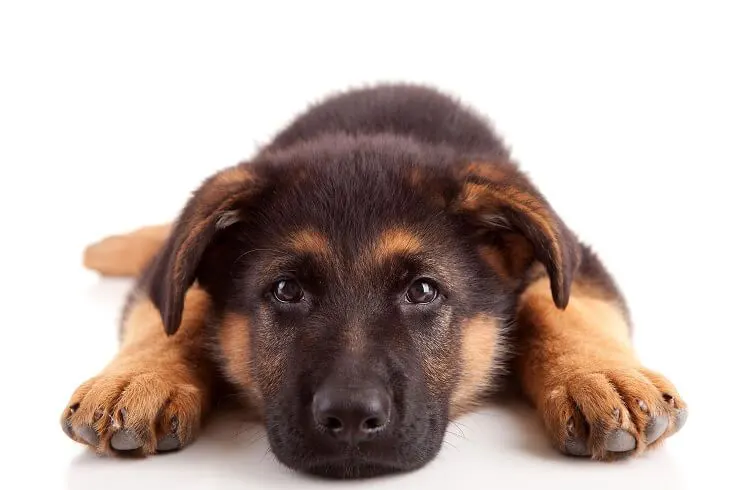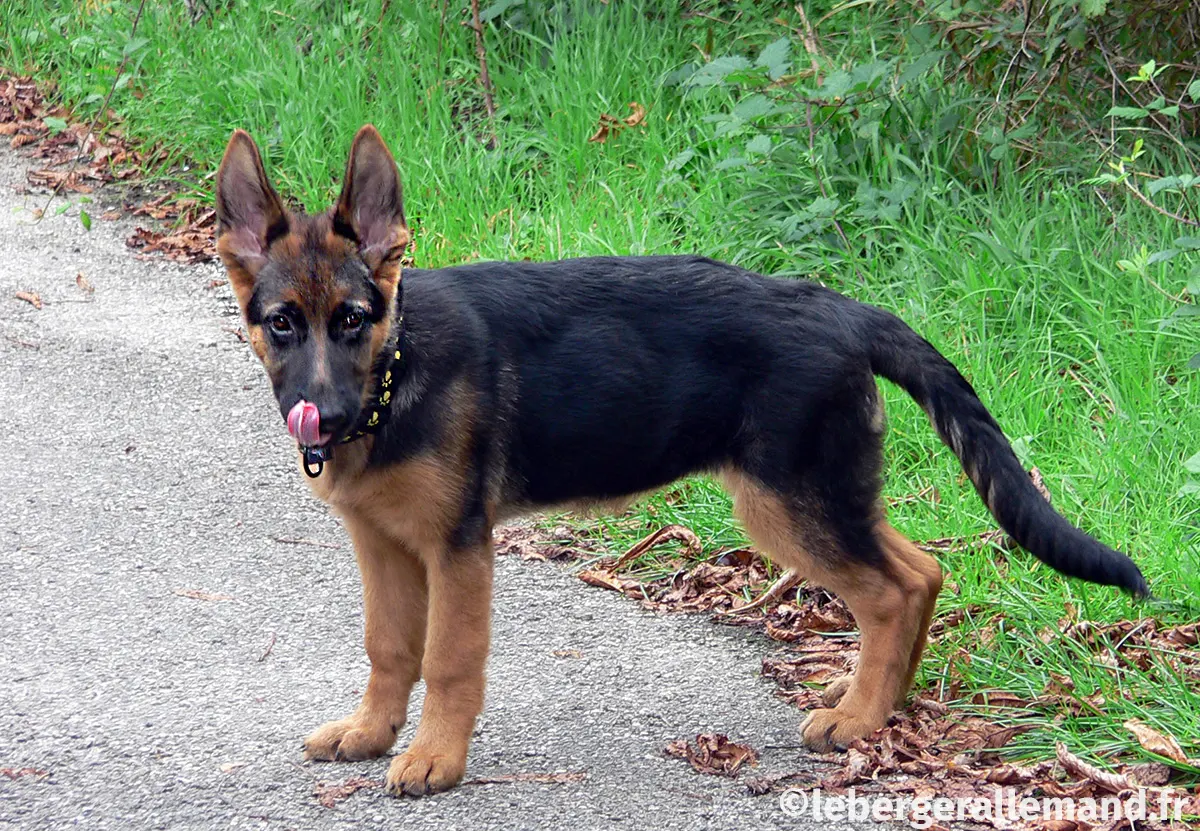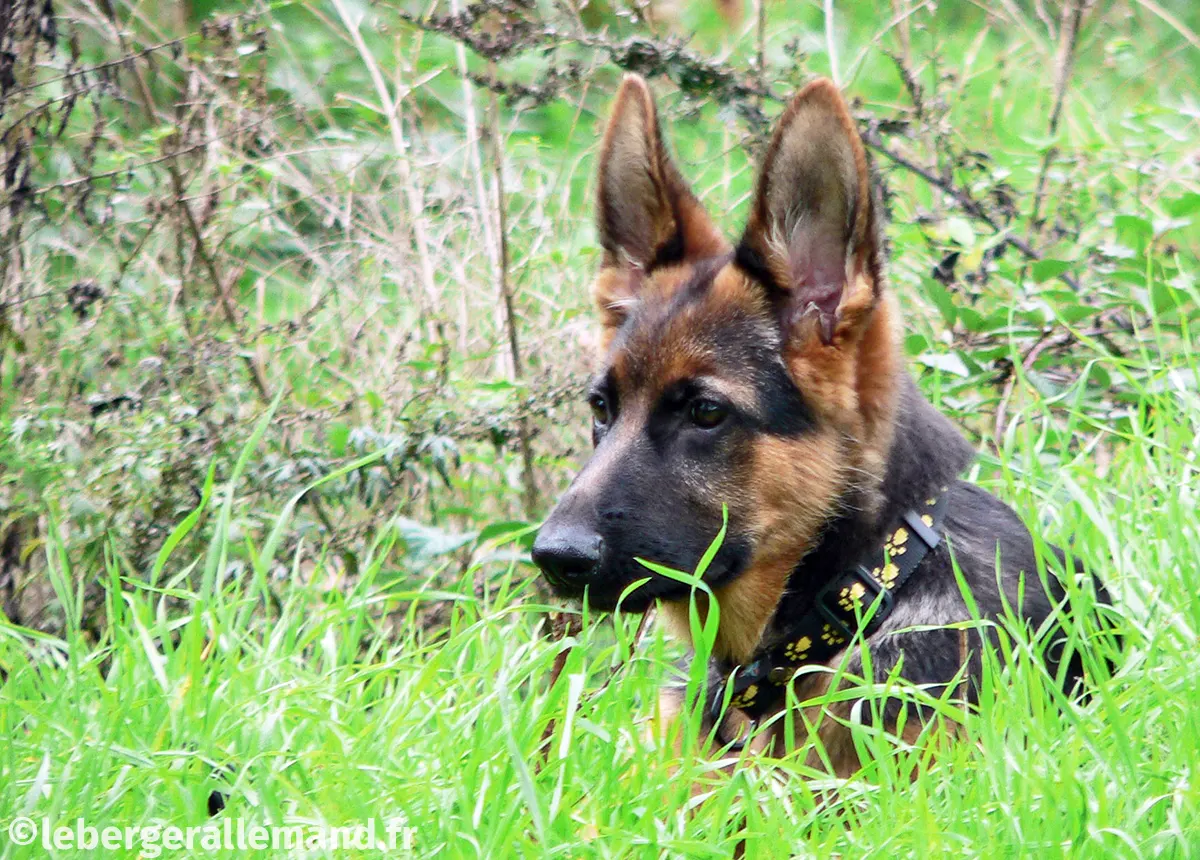Welcoming a German Shepherd puppy into your home means opening the door to a true bundle of energy and vitality! This intelligent and lively companion will surely surprise you with its boundless enthusiasm and constant need to explore. From the very first weeks, you’ll need to dedicate time, attention, and a lot of patience to channel its energy and provide a suitable living environment. Proper preparation is essential to meet its physical and mental needs, fostering its development while building a harmonious relationship.
These tips are not exhaustive and do not replace personalized guidance from a professional canine behaviorist or trainer. Every puppy is unique and may require care tailored to its temperament and environment.
The First Night at Home
🐾 A Spot of Its Own
From the moment it arrives, the puppy should have a clearly defined resting space. This area should be set up in a quiet corner, away from high-traffic zones. This helps your puppy feel safe while avoiding giving it a “strategic” spot from which it can monitor all household activity, which could reinforce controlling behaviors. Avoid elevated sleeping spots such as sofas or armchairs.
🛏️ A Space to Respect
The puppy’s bed or cushion is its personal space. Do not disturb it while resting there, play with it in that spot, or use it as a place for punishment for mischief done elsewhere. This area should always remain a reassuring refuge where it can relax peacefully.
🌙 The First Nights by Your Side
It’s possible for the puppy to sleep in your bedroom during the first nights to feel reassured. If you don’t want this to become a habit, you can gradually move its bed: first near the door, then outside the bedroom, until it reaches its permanent spot.
🌬️ A Little Extra Help if Needed
Some puppies take a little longer to settle. If it still cries at night, you can use calming pheromones, available as diffusers, to help it feel more relaxed.

Feeding
🍽️ A Suitable and Always Clean Bowl
The food bowl is an essential accessory. Opt for metal or ceramic bowls designed for dogs, with a wide base to prevent tipping. Make sure to clean them regularly, and ensure the water bowl is always filled with fresh water.
📏 Properly Measured Portions
Follow the kibble amounts recommended by your veterinarian or breeder. If you want to switch to a different brand of food, always do so gradually over 8 to 15 days, mixing the new food with the old one little by little to avoid digestive issues.
🥩 Beware of Table Scraps
Never give your dog bones from your meals (such as chicken or pork bones). They can cause serious internal injuries or blockages. For its health, it’s best to stick to food specially formulated for dogs.
⏰ Regular and Well-Spaced Meals
Up to 6 months of age, your puppy will need three meals per day. After that, two daily meals are sufficient for the rest of its life. Dogs appreciate routine: try to feed it at consistent times to support its well-being.
💧 Water Available at All Times
Ensure your puppy always has access to clean, fresh water. This is essential to prevent dehydration, especially after exercise or in hot weather.

Housebreaking Your Puppy: Gentle, Patient, and Consistent
When your puppy arrives home, it doesn’t yet understand that going to the bathroom indoors is inappropriate. For it, “cleanliness” simply means avoiding soiling its resting or eating area. You will therefore need to guide it, with kindness, to adopt your idea of cleanliness: going to the bathroom outside.
🕒 Establish a Routine
A puppy learns more easily in a clear and structured environment. To do this, start by:
- Feeding at fixed times, following a consistent schedule.
- Letting it eat quietly, alone, away from the family table. Remove the bowl after 15 minutes, whether it’s empty or not. Water, of course, should always be available.
Since puppies usually need to eliminate shortly after eating, this allows you to anticipate these moments and take them outside at the right time, reinforcing the learning process.
🏡 Limit Space to Gain Control
Reducing the area accessible to your puppy, especially when you are away, will help prevent “accidents” all over the house. Choose an easy-to-clean space — the kitchen, for example — and set up its bed there. Puppies sleep a lot and often need to relieve themselves right after waking up. Take it out immediately after naps to help it get used to going outside.
🚻 Create a Backup Elimination Area
An 8-week-old puppy can usually only hold it for 1–2 hours during the day and 3–4 hours at night. Its ability to hold it remains limited until around 6 months.
If you must be away for a long time, you can set up a “toilet corner” in a small area, using newspaper, puppy pads, or a mop cloth, far enough from its bed and food bowl. The puppy, attracted by the scent of previous eliminations, will return there more easily. However, be aware that this solution may slow outdoor housebreaking, as it gets used to going indoors.
🐕 Frequent… and Appropriate Outings
A puppy needs a reassuring environment to learn to go outside, relying heavily on you at the end of the leash to feel confident. Take your puppy out after every meal, nap, or play session — these moments often trigger the need to eliminate. Usually, it will defecate 10–20 minutes after eating. At first, choose quiet, clean, low-traffic areas, always the same if possible. Returning regularly helps it feel safe and gain confidence, gradually recognizing familiar scents, which makes elimination easier.
🏙️ Busy, noisy places or areas crowded with other dogs and people can easily unsettle or distract a young puppy.
🎾 Avoid playing with it systematically during these outings. If it gets too distracted, it may wait until returning home to relieve itself — where it feels safest!
🩺 Don’t Wait for the Final Vaccines to Go Outside
Contrary to popular belief, waiting until the vaccination schedule is complete to take your puppy out is a mistake.
🌍 Early socialization to the outside world (sounds, smells, traffic, people, other dogs…) is essential before 3 months.
The risk of infection is much lower than the risk of developing lasting fears of urban environments if it has never encountered them as a young puppy.
This is even more important if your puppy comes from a rural breeding environment with no prior exposure to street noises.
⚠️ Some environments should be avoided, especially:
- Areas heavily frequented by other dogs, to reduce health risks or bad interactions.
- Dirty or potentially contaminated places, such as public dog toilets (often called canisettes) found in many cities.
🏡 Start with walks in clean, semi-urban areas, gradually increasing the level of stimulation. This will help your puppy grow into a confident dog, able to relieve itself on a leash anywhere.
🌳 And If You Have a Garden…
Even with access to a private outdoor space, it’s crucial to take your puppy on leash walks outside the home. This reinforces its ability to go elsewhere and contributes to overall balance.
✅ How to Proceed Practically
During outings, let it explore calmly without showing impatience. Puppies may prefer certain surfaces (grass, gravel, sand) that they may have already experienced at the breeder.
Once it has eliminated, you can calmly praise it, but there’s no need to overdo it: the satisfaction of having relieved itself is already a natural reward. Continue the walk afterward to avoid associating “pee = end of walk.”
😴 Accidents Are Inevitable
A puppy needs to be taken out very frequently (up to 8 times a day, including 1–2 times at night). If this isn’t always possible, accept that accidents will happen. The key is to respond correctly:
- Never shout, scold, or punish the puppy, especially if you discover the accident afterward. This teaches nothing except to fear you or hide while eliminating.
- If you catch it in the act, a simple “no” or a noise may be enough to interrupt it. Calmly take it to the desired spot afterward.
- Always praise good behavior, rewarding it when it eliminates in the right place. This is how it learns what is expected.
⚠️ Avoid violent methods such as rubbing its nose in waste, which are traumatic and counterproductive. A puppy’s “guilty look” is actually just an instinctive appeasement signal, not an admission of fault.
🧽 Clean Properly
Preferably use vinegar water to clean accidents, as bleach attracts puppies and encourages them to go in the same spot again.
🎓 Conclusion
Housebreaking is a key stage in a puppy’s life. With patience, consistency, and encouragement, the vast majority of puppies become fully housetrained between 5 and 6 months. Each dog progresses at its own pace, and kindness is the key to successful training. Remember that a behavior that is positively reinforced is learned much faster than one that is punished.

Grooming
🪮 Regular Brushing
A good weekly brushing is usually enough to maintain your puppy’s coat, removing loose hairs and preventing tangles. During shedding periods — typically in spring and early winter — increase brushing to two or three times a week to help it shed its undercoat more easily.
👂 Ear Care
Check your puppy’s ears regularly to ensure they are clean. If dirty, gently clean them with a dog-appropriate ear lotion and a cotton pad or wipe. Avoid cotton swabs: they can push debris further in or injure the ear canal if the puppy moves suddenly.
👁️ Eye Care
Clean the eyes with a dog-specific eye solution. If there is unusual discharge or persistent redness, consult your veterinarian.
🦷 Dental Care
From a young age, get your puppy used to having its teeth inspected. Tartar can lead to serious dental problems. Around 4 months, its baby teeth start falling out — often without you noticing. If you have any doubts about this transition, don’t hesitate to ask your veterinarian for advice.
🐾 Nail Monitoring
Walking on hard surfaces naturally wears down a dog’s nails. Still, keep an eye on them, especially dewclaws (if present), which tend to grow without wearing down.
🛁 Bathing, in Moderation
After the first booster vaccines (wait eight days afterward), you can bathe your puppy. Use a shampoo specially formulated for dogs with lukewarm water. Dry it carefully afterward, being careful not to hold the hairdryer too close to the skin. Don’t bathe too often: excessive washing can weaken the skin.
🧴 Start Early
The earlier you get your puppy used to handling (brushing, care, cleaning), the easier it will accept these routines as an adult. This also makes veterinary exams or future grooming sessions much easier.
Exercise
⚠️ Beware of Overexertion
Even if your puppy is full of energy, it also needs plenty of rest to develop properly. Large breeds, like the German Shepherd, are particularly sensitive to joint problems if they overexert themselves during growth. Avoid stairs, intense running, rough play, or long hikes.
🦴 Respect Growth Limits
During the first year — especially between 2 and 8 months, a period of rapid growth — your puppy is building its skeleton. It is essential not to exceed its physical capabilities. Take the time to observe your puppy to understand it well and adapt walks to its specific needs. Don’t hesitate to shorten the walk if it shows signs of fatigue, or lengthen it if it still seems full of energy. The key is to recognize signals of physical or mental overload and adjust the pace accordingly.
Remember, a successful outing isn’t just about running or playing: it should also include breaks, moments of observation, and calm interactions with the environment. This allows your puppy to develop harmoniously without risking its health.
🔗 Recommendations from Dr. Marie-Eve Cresci, Veterinarian at Vetolistic Clinic
😴 Rest is Essential
Puppies love to play, but they need many naps between play sessions and meals. A good routine alternates gentle activity and rest to meet the young dog’s recovery needs.
🍽️ No Activity Immediately After Meals
Never play with your puppy right after it has eaten: this increases the risk of gastric torsion, a veterinary emergency that can be fatal.
🎾 Safe and Suitable Toys
Provide toys specifically designed for dogs: balls, rings, ropes — as long as they are the right size and made from non-toxic materials. Avoid any items with detachable parts, sharp edges, or that could be swallowed. Also avoid old clothes or shoes, which could create confusion between its toys and your personal belongings.
🔗Playing safely with your dog: choosing the right ball

Socialization
🏠 Exploring Its New Home
From eight weeks of age, a puppy can legally leave its birthplace. It then arrives in a completely new environment that it will need to learn about. The first days are crucial: it’s best to welcome it in a calm atmosphere to allow it to adapt at its own pace.
👶 Foundations Laid from Birth
The puppy was raised by its mother, who taught it the first rules of life. It may have grown up with its siblings, beginning to develop social skills through play, interaction, and sharing. But a change of environment — from the countryside to the city, or vice versa — can be a real upheaval. Sounds, smells, and lifestyle: everything is new.
⚠️ Caution During Exploration
The puppy will naturally want to explore its new territory. Pay attention to safety: chewable objects, household products, electrical cords… Anything within reach can be dangerous. Each puppy is unique: some adapt quickly, others are more reserved. In all cases, give it time.
👨🌾 A Good Start Thanks to the Breeder
Early socialization may have already begun at the breeder’s or first family’s home: daily handling, gentle exposure to different sounds, objects, and experiences. A well-prepared puppy will often be more confident when arriving at your home. If not, don’t worry: you can continue the work with patience and gentleness.
🎵 Gradual Introduction to Daily Life
The role of the new owner is essential. Socialization should continue step by step, without rushing. The puppy must learn to live in a human environment:
- Listening to the sounds of the TV, radio, or vacuum
- Observing the broom or a door opening
- Hearing neighbors, laughter, doorbells
- Meeting visitors, children, and wheeled objects…
🤝 The Importance of Gentleness and Gradual Exposure
Everything should be introduced gradually, in a reassuring environment. The more varied experiences the puppy is exposed to in its first weeks, the more balanced, sociable, and confident it will be as an adult. The goal is not to expose it to everything at once, but to let it discover the world gently, at its own pace.
🧒 Teaching the Puppy to Be Around Children
Learning to live with children is essential for a German Shepherd puppy. Gradually introduce it to children of different ages so it can develop positive interactions and balanced behavior. If you don’t have children at home, try to arrange calm, controlled meetings. Each interaction should be supervised by an adult to ensure gentle and respectful play, avoiding excessive excitement that could stress the puppy. Children, in turn, should learn to respect the animal, its needs, and limits with gentle gestures. This approach fosters trust and makes interactions safe and enjoyable.
🐩 Introducing the Puppy to Other Dogs
Socialization with its peers is a crucial stage in puppy development. Ideally, introduce it to balanced adult dogs that can naturally teach it the rules of canine communication. Choose playmates carefully: a bad example could encourage problematic behaviors. Most adult dogs are patient but will also set boundaries with clear signals (growls, barks) if the puppy is too intrusive or clumsy. These exchanges teach it to moderate its strength and respect social codes. Avoid unnecessarily interrupting these interactions, as it could hinder learning.
🩺 Teaching the Puppy to Accept the Veterinarian
From a young age, get your puppy used to being handled for veterinary exams. Ask family or friends to gently touch its ears, eyes, tail, teeth, and gums, rewarding it after each handling. This helps the puppy associate these actions with a positive experience and remain calm during medical visits.
🌍 Continue Socialization Throughout Growth
The more a puppy is exposed to different environments and people, the more confident and balanced it will be. Socialization doesn’t stop after the first weeks: it should be maintained regularly, especially during adolescence (around 8 months), when the dog may become fearful again and forget some learned behaviors if not sufficiently stimulated. Ongoing socialization is essential for stable adult behavior.
🐾 Need Help with Training?
If you encounter difficulties in training your puppy, don’t hesitate to contact a dog training club, a veterinary behaviorist, or a canine trainer offering individual or group lessons.
❌ Absolutely Avoid: Coercive Methods
Avoid any dog trainer who uses methods based on physical or psychological coercion (prong collars, choke chains, electric collars, physical corrections, shouting, etc.).
